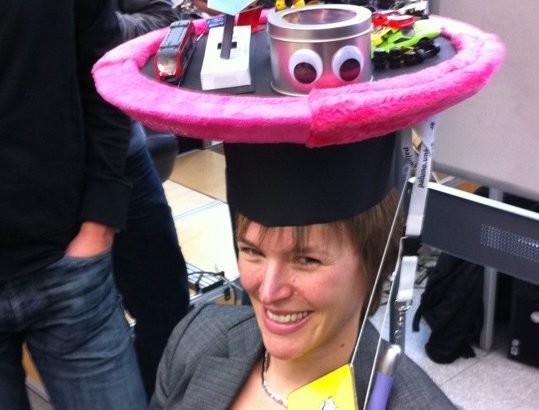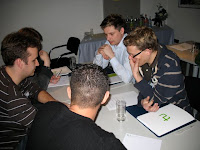Karin Bee (nee Leichtenstern) has defended her dissertation at the University of Augsburg. In her dissertation she worked on methods and tools to support a user centered design process for mobile applications that use a variety of modalities. There are some papers that describe her work, e.g. [1] and [2]. To me it was particularly interesting that she revisited the experiment done in her master thesis in a smart home in Essex [3] and reproduced some of it in her hybrid evaluation environment.
It is great to see that now most of our students (HiWis and project students) who worked with us in Munich on the Embedded Interaction Project have finished their PhD (there are some who still need to hand in – Florian? Raphael?, Gregor? You have enough papers – finish it 😉
In the afternoon I got to see some demos. Elisabeth André has a great team of students. They work on various topics in human computer interaction, including public display interaction, physiological sensing and emotion detection, and gesture interaction. I am looking forward to a joined workshop of both groups. Elisabeth has an impressive set of publications which is always a good starting point for affective user interface technologies.
[1] Karin Leichtenstern, Elisabeth André,and Matthias Rehm. Tool-Supported User-Centred Prototyping of Mobile Applications. IJHCR. 2011, 1-21.
[2] Karin Leichtenstern and Elisabeth André. 2010. MoPeDT: features and evaluation of a user-centred prototyping tool. In Proceedings of the 2nd ACM SIGCHI symposium on Engineering interactive computing systems (EICS ’10). ACM, New York, NY, USA, 93-102. DOI=10.1145/1822018.1822033 http://doi.acm.org/10.1145/1822018.1822033
[3] Enrico Rukzio, Karin Leichtenstern, Vic Callaghan, Paul Holleis, Albrecht Schmidt, and Jeannette Chin. 2006. An experimental comparison of physical mobile interaction techniques: touching, pointing and scanning. In Proceedings of the 8th international conference on Ubiquitous Computing (UbiComp’06), Paul Dourish and Adrian Friday (Eds.). Springer-Verlag, Berlin, Heidelberg, 87-104. DOI=10.1007/11853565_6 http://dx.doi.org/10.1007/11853565_6





























